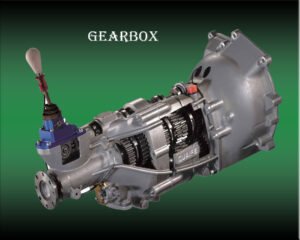
The gearbox is a mechanical or hydraulic system which makes it possible to move a vehicle forwards or backwards by transmitting power and engine torque to the wheels via a transmission shaft and/or half-shaft. The gears of the box all have a different ratio so that the transmission can turn faster, slower, or at the same speed as that of the engine.
What is the role of the gearbox?
The gearbox transmits torque and engine power to the drive wheels. Each gear is adapted to the driving conditions. Depending on the type of gearbox, the first two, three or four gears of the gearbox, or even the five on very recent models, allow the wheels to turn faster than the engine in order to start the car and pick up speed.
A so-called “direct drive” ratio allows the engine and wheels to spin at the same speed. Although the use of direct drive is common, it is not compulsory, especially on cars equipped with low-power engines, the last gear(s) of which are overdrive.
Whatever the type of gearbox, the last gears are generally overdrive, that is to say they allow the drive wheels to turn faster than the engine. This has the effect of requiring less effort from the engine for an equal rolling speed of the vehicle, by reducing the engine speed. This reduction reduces engine wear and fuel consumption.

How it works ?
By changing gears, you change the coordination of different gear wheels in the gearbox. This produces a different gear ratio.
The power of the engine is thus controlled by the gearbox, in order to adapt to any driving situation. The gearbox transmits this force to the drive shafts which turn the wheels. By the way, you can notice immediately if you are shifting into the wrong gear or accelerating too hard when starting off.
In a manual car, the clutch provides the link between the engine and the transmission, so you can change gears by depressing your clutch pedal. With an automatic transmission, this process takes place without the intervention of the driver.
In your car’s maintenance booklet, it is also indicated when to change the oil in your gearbox, . It is very important to take care of your gearbox. If your car reacts unusually while driving, have it checked by a mechanic.
What is the difference between a manual and automatic gearbox?
The manual gearbox requires the driver to change gears himself. Generally, it has 5 or 6 as well as a reverse gear. To shift gears, the driver must press the clutch pedal, which makes it possible to dissociate the elements of the clutch.
He then manipulates the gear lever to up or down the gear. The manual gearbox has the particular advantage of being less expensive than an automatic gearbox. In addition, it allows you to consume less fuel.
Reputed to be more comfortable and certainly easier, the automatic gearbox requires less work from the driver. Indeed, the gears happen by themselves and the car has no clutch pedal. The automatic gearbox therefore has fewer gears, including a Park position, a Drive position to move forward and a reverse gear.
Finally, you should know that the oil used is not the same and that the oil change frequency is different. For automatic gearboxes, the oil change is carried out periodically, approximately every 60,000 kilometres, but the best thing is to follow your manufacturer’s recommendations.
What is the lifespan of a gearbox?
The gearbox is one of the longest lasting parts on a vehicle. By adopting a driving style that respects mechanics and performing oil changes when they need to be, you put the odds on your side to keep your gearbox for at least 300,000 km.
What is a gearbox oil change used for?:
Draining your gearbox is very important if you want to keep it in good condition. This is why it is important to do it in accordance with the recommendations of your manufacturer, which appear in particular in the maintenance booklet for your car.
But why drain? The various gears of the gearbox are constantly activated so that the box plays its role. In order to prevent their wear and overheating, all of these parts are lubricated by oil which is in the gearbox housing.
Replacing this oil is essential to avoid running out of it, but also to prevent the gearbox from being lubricated with used oil. But be careful: do not confuse the gearbox oil change with the engine oil change! They have nothing to do.
Manual gearbox faults
Manual gearbox failures usually occur when gears seem increasingly difficult to shift. One of the main warning signs is the impossibility of engaging a gear without a creaking sensation in the gears, even when the user fully depresses the clutch pedal. Be careful, this can also be linked to poor clutch adjustment.
When the transmission is not completely uncoupled, the gears do not rotate at the same speed, and the synchros no longer manage to do their job. Most of the time, a repair of the manual gearbox will be necessary. Good news, in some cases, there are other much less expensive solutions.

